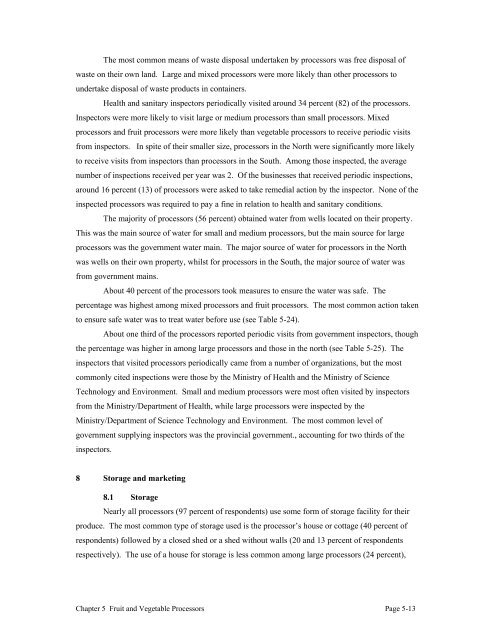Fruits and Vegetables in Vietnam - International Food Policy ...
Fruits and Vegetables in Vietnam - International Food Policy ...
Fruits and Vegetables in Vietnam - International Food Policy ...
Create successful ePaper yourself
Turn your PDF publications into a flip-book with our unique Google optimized e-Paper software.
The most common means of waste disposal undertaken by processors was free disposal of<br />
waste on their own l<strong>and</strong>. Large <strong>and</strong> mixed processors were more likely than other processors to<br />
undertake disposal of waste products <strong>in</strong> conta<strong>in</strong>ers.<br />
Health <strong>and</strong> sanitary <strong>in</strong>spectors periodically visited around 34 percent (82) of the processors.<br />
Inspectors were more likely to visit large or medium processors than small processors. Mixed<br />
processors <strong>and</strong> fruit processors were more likely than vegetable processors to receive periodic visits<br />
from <strong>in</strong>spectors. In spite of their smaller size, processors <strong>in</strong> the North were significantly more likely<br />
to receive visits from <strong>in</strong>spectors than processors <strong>in</strong> the South. Among those <strong>in</strong>spected, the average<br />
number of <strong>in</strong>spections received per year was 2. Of the bus<strong>in</strong>esses that received periodic <strong>in</strong>spections,<br />
around 16 percent (13) of processors were asked to take remedial action by the <strong>in</strong>spector. None of the<br />
<strong>in</strong>spected processors was required to pay a f<strong>in</strong>e <strong>in</strong> relation to health <strong>and</strong> sanitary conditions.<br />
The majority of processors (56 percent) obta<strong>in</strong>ed water from wells located on their property.<br />
This was the ma<strong>in</strong> source of water for small <strong>and</strong> medium processors, but the ma<strong>in</strong> source for large<br />
processors was the government water ma<strong>in</strong>. The major source of water for processors <strong>in</strong> the North<br />
was wells on their own property, whilst for processors <strong>in</strong> the South, the major source of water was<br />
from government ma<strong>in</strong>s.<br />
About 40 percent of the processors took measures to ensure the water was safe. The<br />
percentage was highest among mixed processors <strong>and</strong> fruit processors. The most common action taken<br />
to ensure safe water was to treat water before use (see Table 5-24).<br />
About one third of the processors reported periodic visits from government <strong>in</strong>spectors, though<br />
the percentage was higher <strong>in</strong> among large processors <strong>and</strong> those <strong>in</strong> the north (see Table 5-25). The<br />
<strong>in</strong>spectors that visited processors periodically came from a number of organizations, but the most<br />
commonly cited <strong>in</strong>spections were those by the M<strong>in</strong>istry of Health <strong>and</strong> the M<strong>in</strong>istry of Science<br />
Technology <strong>and</strong> Environment. Small <strong>and</strong> medium processors were most often visited by <strong>in</strong>spectors<br />
from the M<strong>in</strong>istry/Department of Health, while large processors were <strong>in</strong>spected by the<br />
M<strong>in</strong>istry/Department of Science Technology <strong>and</strong> Environment. The most common level of<br />
government supply<strong>in</strong>g <strong>in</strong>spectors was the prov<strong>in</strong>cial government., account<strong>in</strong>g for two thirds of the<br />
<strong>in</strong>spectors.<br />
8 Storage <strong>and</strong> market<strong>in</strong>g<br />
8.1 Storage<br />
Nearly all processors (97 percent of respondents) use some form of storage facility for their<br />
produce. The most common type of storage used is the processor’s house or cottage (40 percent of<br />
respondents) followed by a closed shed or a shed without walls (20 <strong>and</strong> 13 percent of respondents<br />
respectively). The use of a house for storage is less common among large processors (24 percent),<br />
Chapter 5 Fruit <strong>and</strong> Vegetable Processors Page 5-13
















